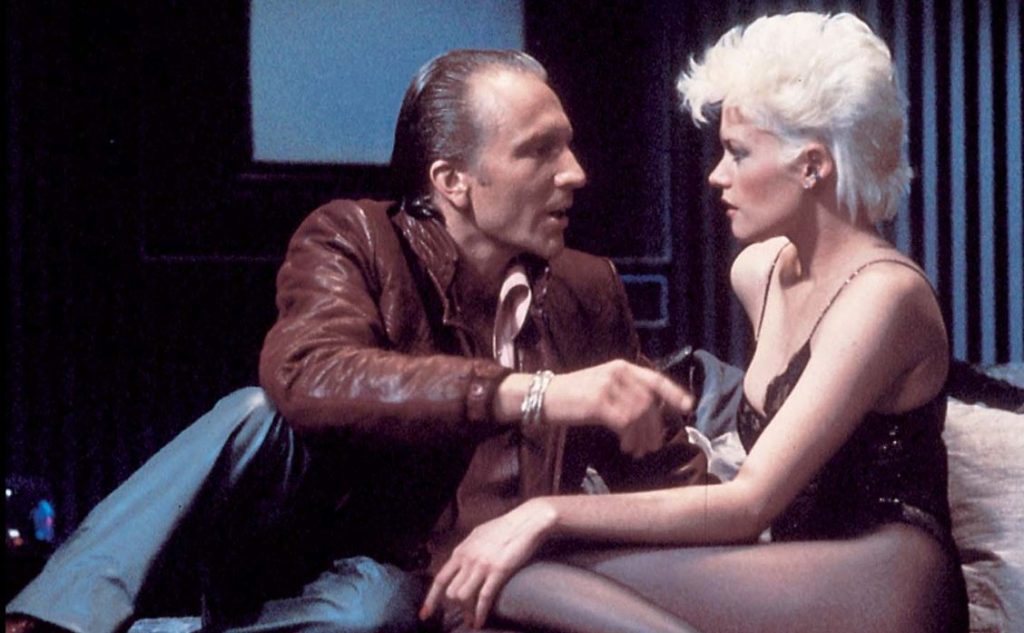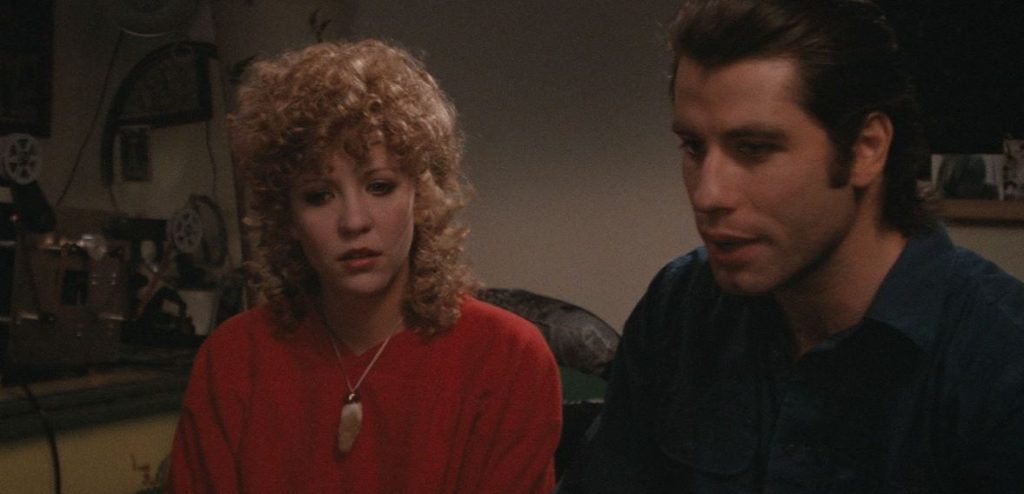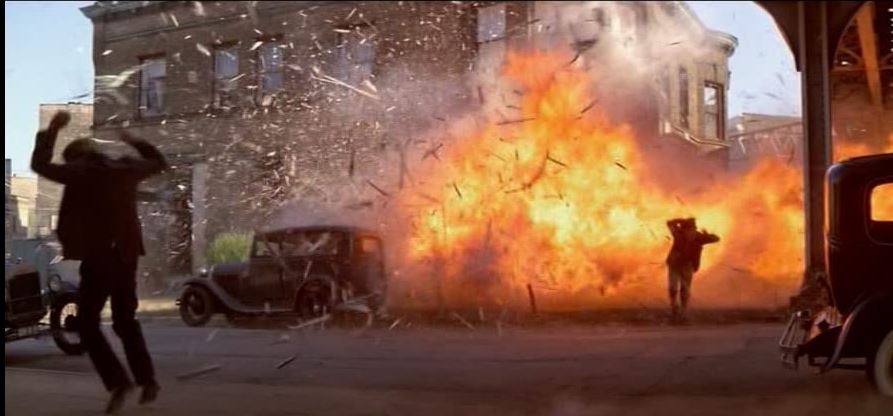
There’s only one way to describe Brian De Palma’s five-decade-long career: all over the shop. There have been glorious artistic highs, far too many Hitchcockian homages, the odd mainstream megahit, a sprinkling of high-profile awards, condemnation for tawdry subject matter, a pronounced tendency to work with the same collaborators both in front of and behind the camera, atrocious attempts at comedy, a fair bit of mediocrity and some whacked out moments along the lines of Dear God, man, what were you thinking?
One thing’s for sure, though, and that’s De Palma knows how to move the camera. Yes, he might be guilty of flamboyance and self-indulgence with his three-sixty pans, split screen shenanigans, elaborate tracking, lengthy takes and plethora of POV shots, but there’s no denying the guy’s visual style or the sheer bloody imagination involved. Christ, sometimes he makes the goddamned camera swoop. At other times his fondness for split-focus trickery enables him to come up with some startlingly intimate moments, such as Blowout’s John Travolta in the background next to an up-close hooting owl. De Palma is also a true believer in the magic of suspense and often takes great care setting up key events, a characteristic plain to see in a flick like Carrie as we wait an age for a bucket of porcine blood to drench our newly crowned prom queen.
De Palma started in the late sixties, gaining traction in 1972 with his first horror flick, Sisters. Sisters starts well but falls apart as soon as it introduces its highly implausible Rear Window aspect, complete with a shrill, wannabe investigative reporter. It’s since become a cult favourite (and does feel like a forerunner to Cronenberg’s body horror stuff) but I find it overwrought, poorly performed, full of ropey dialogue, and ultimately incomprehensible. However, it’s an important entry in the De Palma canon as it was the first to link sex, blood and violence. More importantly, Sisters made money, as did the Vertigo-flavoured, exceptionally daft and slow as molasses Obsession four years later.
De Palma was up and running, managing to deliver his first masterpiece in the shape of 1976’s bloody amazing Carrie. This paranormal high school flick, which revels in repressed female sexuality, bullying and religious mania, is a darling of mine and one of the fastest hundred minutes I’ve ever watched. From here on De Palma was no longer an indie filmmaker but an important, polarizing figure whose name was often in the frame for Hollywood’s juiciest projects. Indeed, he turned down Flashdance, Fatal Attraction and, most intriguingly, Schindler’s List. Can you imagine if he’d got his tacky little hands on that one? Liam Neeson probably would’ve ended up perving on some hot doomed Jews in the showers. I jest, but accusations of rank insensitivity, exploitation and misogyny have long dogged De Palma, especially during his 80s heyday.
Hey, that’s gotta be preferable to blandness.

Goofy bollocks: The Fury (1978), Dressed to Kill (1980) & Body Double (1984)
De Palma followed Carrie’s big success by doing his best to restage it in The Fury. Once again, we have telekinesis, an emphasis on blood, and even a high school bitch. However, whereas Carrie was a small story, Fury is much more ambitious with its terrorist beach raid, secret government agencies, and talk of a ‘bio-plasmic universe’.
Amy Irving, who played a remorseful bully in Carrie, is another troubled schoolgirl (despite the fact she’s pushing twenty-five) in possession of psychic abilities. Bad guy John Cassavetes, complete with a black-gloved hand in a black sling, wants to turn her into a governmental weapon to fight the Soviets. Meanwhile, an aging Kirk Douglas is trying to recover his similarly clairvoyant son from Cassavetes’ clutches by occasionally impersonating an explosion-proof Spiderman.
This is two hours of nonsensical cheesy guff, littered with below par performances, exploding cars, miraculous escapes, Arabs spinning out of control and angry pole vaulting. De Palma ditches the split-screen stuff but otherwise has fun with a bag of visual tricks that includes extrasensory visions and simultaneous presents while repeatedly showing a bodily explosion from different slow-mo angles (a la the famous flying sheet of glass decapitation in The Omen). The Fury might not convince for longer than a minute at a time, but it’s amusing enough and turned into a decent-sized hit.
In the ladyboy-flavoured Dressed to Kill there’s yet more of a Carrie overlap when De Palma starts with a naked female (Angie Dickinson) in a steamy shower soaping her body as lush music plays. Now I’m a fan of Ms. Dickinson. She’s a classy broad and here she makes me paw the floor and howl at the moon, but De Palma’s depiction of her as a sexually frustrated housewife in therapy who can’t hang onto her gloves, wedding ring or panties is borderline hysterical.
This is not the film’s only problem. Check out the obnoxious, badly dressed Dennis Franz (of NYPD Blue fame), giving another ridiculous performance as a cop to complement the wide-eyed one he served up in The Fury. Then there’s the rotten Nancy Allen, so good as Carrie’s queen bitch, who fails at every turn as a high-class hooker. Plus, we get a teenage electronics geek playing amateur detective, a diabolical subway sequence, and the overripe dialogue, such as our transsexual slasher telling psychiatrist Michael Caine: “Oh, doctor! I’m a man inside this girl’s body and you’re not helping me to get out… Don’t make me be a bad girl again.” In short, De Palma’s writing discipline frequently evaporates.
Dressed to Kill is explicit, sub-Psycho mischief. It has a definite sex and punishment vibe and proved to be one of the director’s most controversial offerings. In the UK it was released at the height of the Yorkshire Ripper’s reign of terror while others objected to its portrayal of a ladyboy as an unhinged, razor-wielding murderer. I get the first reason for its contentious reception, but have much less sympathy for the second on the grounds that ladyboys don’t have any right to be depicted on film as lovely, well-adjusted people. I appreciate they’re a minority, but it’s up to people to understand movies are not factual and their directors/writers shouldn’t be accused of bigotry if they happen to show particular individuals in a less than favourable light. Cinemagoers would be better off basing their opinions of minorities (or run of the mill people like psychiatrists) on their real-life interactions with them.
For example, I once taught English to a couple of Thai ladyboys, the one proving to be a lively, interesting guy who often turned up to class in a fabulous black gown, a Gucci handbag and diamond earrings. Boy, did I feel slovenly next to him groping for my coffee at 8.30 each morning. Apart from that, he’d regale me with tales of his debauched weekends in Sydney with a sugar daddy, his excellent grasp of spoken English routinely punctuated by an obsessive need to check his reflection. All these years later I still think well of him and shall always have a certain amount of respect for any surgically enhanced bloke who slaps on a dress and walks down the street. Plus, it’s important to note that despite having watched Dressed to Kill a good few times by the time he became my student, I don’t ever recall fearing he was about to attack me with a razor or do something similarly nuts. Now if a thicky like me can tell the difference between real life and some nonsense in a movie, surely others can, too.
Anyway, Dressed to Kill is an essential entry in De Palma’s catalogue. It might be bloody awful, but I can’t help enjoying the way its eye-rolling silliness ploughs on for a further fifteen minutes after it’s already found a daft ending.
And then we come to the equally far-fetched Body Double in which Craig Wasson tries to hold the centre. Not sure how anyone could mistake this wan shortass for the natural choice to star in an erotic thriller, but De Palma’s meta movie would have struggled with its rampant implausibility and overlong runtime even if he’d got the casting right. Wasson limply plays a naive, oversensitive, recently fired actor who gets sucked into a web of intrigue when he starts spying upon a gorgeous rich woman cavorting nightly in front of her window. This is one dull, confusing, action-light watch, although I am fond of Frankie Goes to Hollywood weirdly popping up at the halfway point, a dog managing to headbutt its way through a car window and the scene in which Wasson perves on the object of his obsession as she slips into some sexy undies in a boutique changing room while he stands outside in the street. Gotta give De Palma credit for shoehorning in a bout of voyeurism wherever he can.
Things continue to deteriorate with an unintentionally funny Vertigo-style wig out in a tunnel (that’s on a par with Dressed’s dire subway sequence) and the introduction of the ear-offending Melanie Griffith. She plays a porno actress who quickly informs us she’s not into bestiality or fist fucking. Nor, it appears, good movies. You know Body is a stinker because that Huey Lewis-loving arbiter of good taste, Patrick Bateman, loves it.
Unlike Fury and Dressed, Body flopped at the box office. All three are best treated as convoluted comedies and although it’s tricky to work out the goofiest, Body sure feels like the longest.

Half-decent efforts: Blowout (1981), The Untouchables (1987) & Casualties of War (1989)
De Palma’s fondness for paying homage/ripping-off stuff was once again laid bare when he came up with the mystery thriller, Blowout. Clearly inspired by the likes of Blowup and The Conversation, it’s another meta movie that reunites Nancy Allen and John Travolta, five years after her pussy fumes got him so high in Carrie he happily used a sledgehammer to bash in a pig’s brains on her behalf.
Travolta is a movie sound effects recordist, a talented but guilt-ridden slummer who’s adding screams and the thumps of falling bodies to low-budget horror flicks, such as Bad Day at Blood Beach. (Amusingly, there’s also a poster of the real-life turkey Empire of the Ants on his workplace’s wall). Travolta’s job enables De Palma to have fun parodying slasher cliches that were all the rage in the early 80s. Hence, we start with a heavy-breathing killer lurking outside a girls’ dorm as he peeps at a masturbating female, students fucking on the floor and a naked hottie in the shower.
Shortly afterward, Travolta inadvertently records a car plunging off a bridge on a quiet country road. Inside are a rising political star and the slutty, would-be blackmailer Allen (apparently channelling Marilyn Monroe’s voice). Blowout is a little talky and contrived, especially when a hired bad guy bizarrely goes off the rails to become a serial killer. Still, it’s as well directed as any of De Palma’s movies, its reputation is growing, and its final twenty minutes/’good scream’ coda are worth the wait. Travolta shows how charismatic he can be when given the right material, but his performance neither prevented Blowout from flopping nor his sad entry into a thirteen-year-long artistic wilderness that only ended when handed the Pulp Fiction script.
Whereas Blowout is filled with trademark De Palma tricks, The Untouchables is a lot more restrained. Only the elaborate train station sequence, in which a pram-bound baby bumps down some stairs during a shootout, comes close to the director’s showy style, but I’d argue it’s the least convincing scene in the entire thing (and deservedly mocked in a Naked Gun sequel). No matter, because elsewhere the big hit The Untouchables delivers.
Kevin Costner plays good guy government agent Eliot Ness during the dark days of Prohibition. He’s been tasked with cleaning up Chicago, a town that ‘stinks like a whorehouse at low tide.’
And the reason for the stink? Mr. Al Capone.
We’re introduced to this boorish thickie as he’s pampered by lackeys in front of a fawning press pack. He tells them he’s ‘responding to the will of the people’ by supplying illegal alcohol, a cheeky stance built on a fair amount of truth. However, he also denies using violence because it’s ‘not good business’. Moments later a henchman is seen leaving a bomb in the establishment of an uncooperative businessman, resulting in the obliteration of a darling little poppet. Mr. Capone, it appears, is not quite telling the truth.
De Palma’s smoothly paced depiction of such violence is interesting. Perhaps burned by all the grief he got from the Dressed to Kill/Body Double decriers, his tone wavers. It’s near-jovial during part of Ness’ raid on an incoming Canadian booze shipment while he disappointingly omits the skull-denting moment Capone’s baseball bat meets a bonce. De Palma being coy…? No, thanks! Things mercifully get back to normal in a tremendous elevator massacre that echoes Dressed to Kill’s signature murder.

Throughout Untouchables De Palma’s sense of 1930’s Chicago is on the money along with Ennio Morricone’s score and some decent acting. I’m no fan of the competent Costner, but he’s well-cast here as the straightest of straight arrows (“Let’s do some good!”) However, he was always going to play second fiddle to Connery’s beat cop charisma and De Niro’s proven gangster class. The Oscar subsequently handed out to Connery seems a little generous, especially given his mangled attempt at an Irish accent, but a paunchy, balding De Niro has fun in just about every scene, especially when ranting: “I want you to find this nancy-boy Eliot Ness and I want him dead! I want his family dead! I want his house burned to the ground! I wanna go there in the middle of the night and piss on his ashes!” The Untouchables is a bit too straightforward to be a great gangster flick, but it remains a solid, watchable one.
Casualties of War, however, is a lot less fun. It arrived during the second wave of Vietnam War flicks, but its grim subject matter didn’t exactly have folks lining up around the block. Now De Palma has long run into flak for his portrayals of sexualized violence, such as the phallic drill murder in Body Double, but Casualties was perhaps a counter move with its hard, stone-cold sober look at a spot of murderous gang rape. Based on a real-life incident, it portrays the military mind as macho, stupid, cruel, subservient, bullying, and utterly lacking in imagination.
In short, pretty much everything I always suspected.
In the straightforward, clip-filled 2015 doco, De Palma, in which the director discusses his body of work in chronological order, he admits Casualties was not only a movie nobody wanted to make (with a long history of being developed and shelved), but also one he finds hard to watch. “It felt very much the way I feel about these types of wars we get into where nobody knows why,” he says. “To me, it’s a metaphor for what we are doing: we are raping these countries.”
A young, resentful Sean Penn lords it over a squad of Neanderthal malcontents, most of whom are racist, sexist and aching to crack heads. Listen to his immediate subordinate Corporal Clark (Don Patrick Harvey) musing about what to do on a night off: “We’re gonna get shitfaced and go hump the brains out of some of those dink hos.” Clark’s lack of enlightenment soon turns nihilistic. “I hate this fucking place. They ought to blow it up and pave it over. Total fucking destruction is the only way to deal with them.”

It’s up to the baby-faced, three-foot high Michael J. Fox to do his best to suggest not every grunt is a fuckwit. And so, he hands out chocolate bars to the locals, helps with the ploughing and naively believes the troops are there to benefit Southeast Asia. Nice try, son, but that’s not much of an offset when the rest of your squad is abducting a teenage girl from an isolated village during a long-range patrol. Fox is not happy about this development and quickly becomes the voice of our conscience, but his pained face and little speeches don’t exactly make for riveting cinema. Indeed, he’s badly miscast (although it was his post-Back to the Future/Teen Wolf star power that got the flick made in the first place). Supposedly a married father, he looks like he should be back in America planning his school prom rather than standing up to fragging-inclined bullies and the army’s disinterested, shit-kicking commanders. I kept expecting him to jump on a skateboard or try to wheel the traumatized girl away through the jungle on one.
Saying all that, the heavy-handed Casualties does have its strengths. The tobacco-chewing, thoroughly unpleasant Penn (who sees nothing wrong in using another human being as a bit of ‘portable R and R’) is effective. The abducted Vietnamese girl is also good, radiating helpless terror as well as The Shining‘s Shelley Duvall. Casualties’ main problem, though, is it’s all a bit workmanlike, earnest and dour.